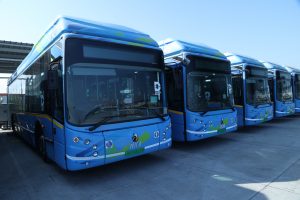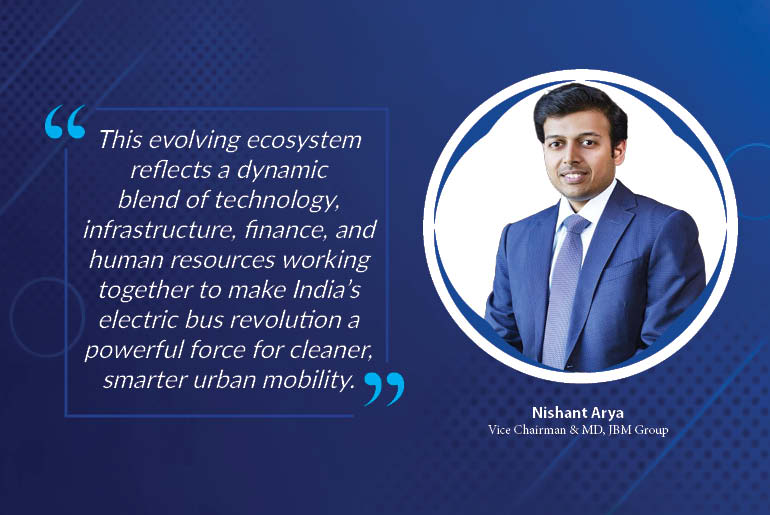India is set to become the 3rd largest economy by 2030 with a $7 trillion GDP. The Government of India’s 7Cs Mobility vision is built to address India’s unique geographic landscape addressing its various challenges, shaping the future policy direction. Advanced technology led mobility solutions designed towards decarbonisation, electrification and sustainability are driving the future of mobility in India.
India’s transition to electric mobility has emerged as a global benchmark for various countries aiming to induct sustainable & green transport. The global EV market is projected to exceed $2 trillion by 2033 with India spearheading this momentum actively anchored by the government, reshaping the face of urban transport and sustainability. The Indian government has been inducting transformative policies, driven by the strategic public-private partnership model to accelerate the deployment of EVs across the nation, especially in the public transportation domain led by rapid deployment of electric buses across various states.
Public transport has been the backbone of urban mobility in India. With more than 800,000 buses on the road, their transition to electric holds the key to promote lower emissions and smarter cities. Over the past few years, electric bus fleets in India have surged across major urban hubs from Delhi, Mumbai to Telangana and Tamil Nadu, showcasing India’s proactiveness in embracing greener public e-mobility solutions rendering cleaner air, quieter streets and higher reliability standards.

Under the PM E-Bus Sewa (PM E-Drive) scheme, the government aims to deploy 10,900 e-buses through a Gross Cost Contract (GCC) model while creating up to 55,000 new jobs. By August 2025, approvals for over 7,000 electric buses spanned 14 states and 4 Union Territories. Ambitious targets set by leading cities include Delhi’s aim for 8,000 e-buses by February 2026 and Mumbai’s goal of a fully zero-emission fleet by 2027. This momentum continued with more than 2,100 electric buses registered in the first half of 2025 alone, marking a 33% rise from earlier months. While electric buses are gradually catching up in ICE dominated market, they are pivotal to India’s agenda for modernizing urban transport and achieving cleaner, greener mobility by 2030, aligned with the broader mission NetZero by 2070.
India’s early adoption of electric public mobility has provided key lessons across states and cities, especially highlighting the urgent need for integrated charging infrastructure tailored to bus operations. Unlike passenger electric vehicles that rely on scattered public charging points, electric buses require high-power depot-based charging aligned with their schedules. Developing durable, reliable depot facilities capable of managing large battery capacities and peak energy demands without overloading local grids is critical to reducing downtime and ensuring smooth service.
Managing large electric bus fleets also demands continuous data-driven oversight. Fleets generate millions of daily performance data points, enabling operators to implement predictive maintenance that safeguards battery health and optimal scheduling before breakdowns occur. This approach reduces unplanned downtime, extends vehicle lifespan and highlights the increasing importance of digital fleet management platforms in scaling electric mobility successfully.
Workforce development is equally vital in enhancing uptime and operational safety. Electric buses carry high-voltage systems that require strict safety protocols, making driver and technician training indispensable. Trained drivers not only ensure safety of passengers but also learn to optimize energy use through techniques like regenerative braking, improving efficiency and, thereby, lowering costs. Meanwhile, operators face ongoing challenges in preparing skilled technicians equipped to maintain increasingly sophisticated drivetrains, battery systems and fast charging setups. Successful programs, such as UITP India’s exchange workshops, demonstrate the lasting advantages of investing in people alongside technology to sustain and scale the electric bus revolution.
Financial frameworks also affect uptime and operational stability. To support operators, the Government of India has launched key initiatives addressing payment delays and financial risks. The PM-eBus Sewa-Payment Security Mechanism guarantees timely payments via escrow accounts and dedicated funds, enhancing operator confidence. Complementary schemes like FAME Phase II and PM E-DRIVE offer procurement subsidies and incentives, while special financing facilities aim to ease capital costs for State Road Transport Undertakings. Together, these efforts strengthen financial viability and accelerate nationwide electric bus deployment.
Technologically, India’s electric bus sector highlights the importance of customized solutions for its diverse and often extreme operating environments. Battery modularity coupled with advanced Battery Thermal Management Systems (BTMS) plays a critical role, especially given the country’s varied climates – from the freezing north and north-east to hot, humid southern and coastal regions. Additionally, lessons from metros and smaller cities reveal that customizing bus configurations, with considerations for local traffic patterns, stop frequency and climate, significantly enhances efficiency and uptime.
Lastly, while megacities spearhead adoption, expanding electric bus networks to smaller cities and peri-urban areas, home to a large portion of India’s population, remains critical. Electrifying the country’s vast transport system is therefore central to addressing these concerns. The government’s aim to electrify 30% of the national vehicle fleet by 2030 is an important step in ultimately achieving net-zero emissions by 2070.
This evolving ecosystem reflects a dynamic blend of technology, infrastructure, finance, and human resources working together to make India’s electric bus revolution a powerful force for cleaner, smarter urban mobility.

